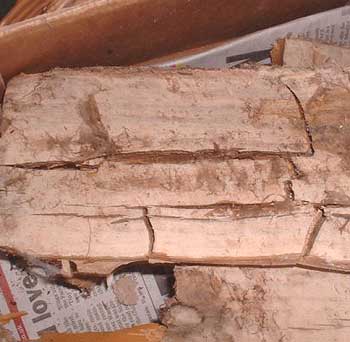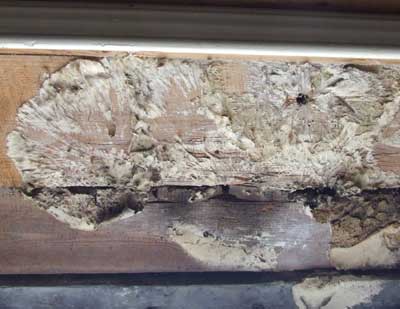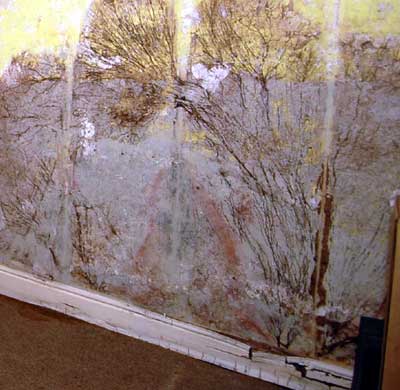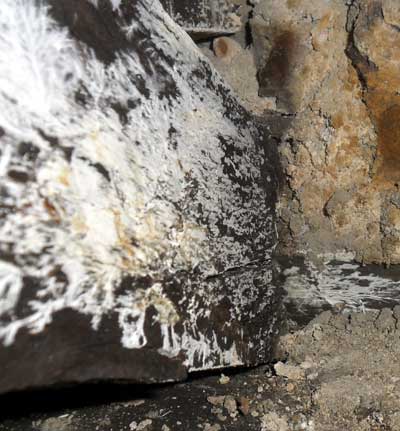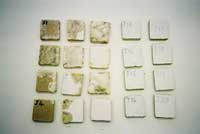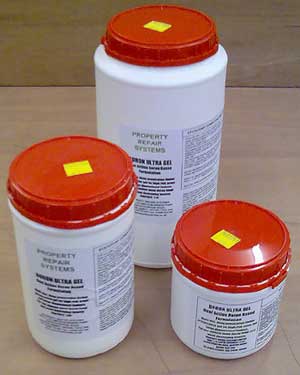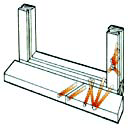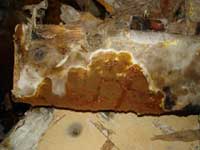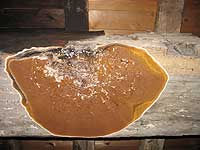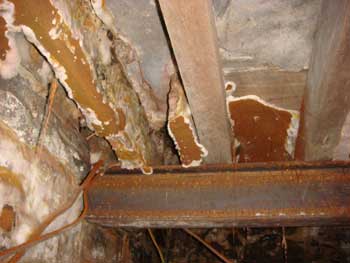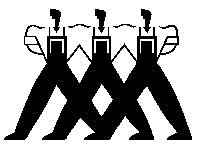How do you tell the difference between Wet Rot and Dry Rot and why bother?
It is not easy to tell the difference between Wet Rot and Dry Rot because there are many types of Wet Rot and many of their characteristics are similar to those of Dry Rot. Luckily there is only one Dry Rot, so the easiest way to check for Dry Rot is to look for the four main identifying features - if none of them is present the rot is probably a Wet Rot.
Click here to read the four main features of Dry Rot
You need to bother to tell the difference because of one key feature of Dry Rot - it can travel over dry surfaces, even chemically treated surfaces (if dried out) to find moist wood to attack. Wet Rots cannot do this, because they need high levels of moisture to spread within. So, Wet Rots are much, much safer, because they cannot spread beyond the area of dampness, and that dampness has to be quite severe, thus making it more obvious and easier to isolate.
Why Treat Wood for Wet Rot?
Strictly speaking the Wet Rot itself does not need treating. Simply remove the source of moisture and the Wet Rot will die. It cannot spread without water, so in theory no further action is required. However, this idealist approach ignores the practical reality. Once you have stopped the water coming in and cut out the physically weakened wood you will often be left with surrounding timbers that are perfectly sound, but are significantly damp. These pieces of wood make take many months, or even years to dry out - this is when they are highly vulnerable to an attack of Dry Rot. So you must check the remaining timbers for moisture content and if in doubt treat them with Boracol 10 , Boron Paste and Boron Gel, to ensure that they remain rot free whilst the moisture content falls into the safe zone. Timber below 18% WME (as measured on a calibrated, good quality 'Damp Meter' ) cannot be attacked by Dry Rot.
Why Treat Wood for Dry Rot?
Because Dry Rot can spread across most surfaces, even behind plaster and skirting boards, even when the moisture content is below the required level for decay. Any piece of timber over which strands, mycellium or a fruiting body of dry rot is growing must be treated with a Boron based product at least 300mm in all directions, to avoid any of the tiny micro strands of Dry Rot, that precede the main visible parts of the fungal growth inside the timber, from growing. These micro strands are tiny, and not visible to the naked eye.
Click here to see the products, check prices or place an Order
What are the main features of Dry Rot - first identify the rot type in order to decide the extent of the treatment
1. Strands - fibres, that look like small plant roots, dirty off-white to silver grey in colour. Can be confused with some Wet Rots.
2. Sheets - called Mycelium - looks like a dirty off-white skin, can be tinged with yellow, occasionally found as billowing cushions of off-white growths. Can be confused with some Wet Rots.
3. Mushroom - Fruiting Body - this produces the Spores - rust red in colour, can spread around onto other surfaces, usually found as a flat body with red spores in the centre and an off-white rim. Very, very distinctive and quite rare - not usually confused with any other Rot, but can look a bit like brick dust.
4. Cubing - wood breaks up into large cubes, but with larger, deeper cracks along the grain than across the grain. Often confused with Wet Rots, some of which produce similar cuboidal cracking, but with much smaller true cubes, rather than the more rectangular Dry Rot type.
Dry Rot - large splits, curvature and strands.
Note the 'cuboidal' type cracking.
Mycellium on wood - NOT brilliant white.
More of a dirty, off white to grey colour.
Dry Rot Sporophore - flat & red rust coloured.
Fruiting body is very distinctive, usually with red dust everywhere around.
Which of the many Wet Rots could it be - most commonly misidentified features
1. Coniophora puteana - the 'cellar fungus' - dark brown to black strands in fern-like patterns, olive brown fruiting body (rare).
2. Fibroporia vaillantii - white strands in fern like growths, white fruiting body with pores.
3. Asterostroma - brilliant white, fine strands, fruiting body has no pores, mycelium has tiny star structures, visible only under magnification.
Wet rot - brown to black strands of Coniophora.
Brilliant White strands and Mycellium of Fibroporia
Brilliant White strands and Mycellium of Fibroporia - both Wet Rots - NOT Dry Rot.
You have identified the Rot - now use Boron treatment
The best, safest and most pleasant treatment to apply is Boracol 10 , a water based 'biostat' that has no adverse effect on non-wood boring insects or mammals (like Bats). This Boron Products is applied as two or more coats by brush or spray and soaks quickly into the timber. It is permanent and, unlike its main rivals, it has no vapour and no smell. It can only affect wood rotting fungi and wood boring insects, so Bats (a protected species) are not affected - their main food, the house fly, does not eat wood and so it never contains any preservative. Heavily infested areas of timber, and damp patches, should also have an application of Boron Ultra Gel, to reduce the risks of future rot and provide extra active ingredient. Permanently or seasonally damp wood needs injection with Boron Ultra Paste and the insertion of Boron Ultra Rods (for example, window frames, garden posts, door frames).
Usage rate - use our chart of hole spacing for various timber sizes as a guide, or call us on 01626 872886 and we'll calculate your exact requirements. (Hole Spacing Guide - click here to download)
How to prevent the spread of Dry Rot - Dry Rot Paint around and over timbers
The photograph below shows untreated panels, on the left and treated panels on the right. The treated panels (in two columns) have been painted with Dry Rot Paint and show no signs of growth!
So, you can further reduce the risk of future Dry Rot attack by using this 'No Go Zone' special emulsion paint. It can be applied behind skirting boards, in window frame reveals and in joist sockets. The paint, which has been tested by BRE (Building Research Establishment - Government backed test Authority) prevents Dry Rot from passing across treated areas. No other treatment can currently offer this feature.
If you need any help with any type of Wood Treatment or identification of wood rotting fungi Property Repair Systems staff will be pleased to give you completely free, no obligation advice on 01626 872 886 .
RING US FOR HELP TO IDENTIFY YOUR FUNGUS - 01626 872 886 - Fungus Help Line
BORON GEL, PASTE, RODS - treatment to kill and prevent insect and Dry Rot attack
1. ECOBOR ULTRA GEL - Surface Applied Gel for Dry Rot
An active clear Boron based Gel ideal for end grain and bearing area treatment of beams and joists. Apply to surfaces that have been touched by or affected by Dry Rot.
Also useful for medium to heavy active infestations of insect attack and treatment of new timbers for use in vulnerable areas (e.g. skirting boards).
Boron Ultra Gel in three sizes - 500cc, 1 litre and 2 litres - no odour, easy to brush.
Click here to see Prices or Buy
2. BORON ULTRA PASTE - Deep Injected Treatment for Dry Rot - no odour
A unique Boron based paste using a special blend of technical grade glycols as carriers. It can be injected into timber, with the advantage of supplying a highly concentrated mobile preservative which will spread even at low moisture content levels. Simple to apply with a standard skeleton gun; more effective to use because of the higher available level of active content, which allows the use of smaller (8mm, rather than 10mm) and/or fewer drill holes.
Boron Paste in a mastic tube, with an extension adapter nozzle. For injection into wood to kill dry rot and insects.
Also available - Timber Paste for dry wood - ideal for fully indoor structural timbers that are suffering from Death Watch Beetle, House Longhorn Beetle or Termites.
Usage rate - use our chart of hole spacing for various timber sizes as a guide, or call us on 01626 872886 and we'll calculate your exact requirements. (Hole Spacing Guide - click here to download)
Click here to see Prices or Buy
3. BORON RODS - Solid Rods for embedding Boron inside holes in wood - prevents and kills Dry RotThese solid rods of Boron based compound are used to protect timbers which are constantly or occasionally damp: external joinery, wall plates, embedded beam ends, posts etc. They can also be used in conjunction with BORON ULTRA Paste, to act as a long term reservoir (Standard Sizes - 8mm x 24mm and 8mm x 65mm).
Packets of Boron Rods as solid fused sticks of preservative. Example of insertion in a frame.
Usage rate - use our chart of hole spacing for various timber sizes as a guide, or call us on 01626 872886 and we'll calculate your exact requirements. (Hole Spacing Guide - click here to download)
Click here to see Prices or Buy
4. DRY ROT PAINT - Special Emulsion Coating - low odour (non Boron)
A specially treated preservative biocidal emulsion paint designed to prevent the surface spread of Dry rot. Ideal for timber and masonry in the treatment of adjacent areas, to provide visual lasting evidence of treatment. It prevents surface spread of strands and mycelium.
Some Site photographs showing how Dry Rot can spread - often in hidden places below or between floors.
Click here to see Prices or Buy
Benefits of Borax Boron based for Dry Rot treatments
* Boron has a world-wide safety reputation - 5% products still require no hazard warnings
* Borates have ultra low toxicity - about the same as Table Salt
* Boron based preservative kills only wood rots and wood boring insects - not spiders, birds or bats
* Boron has no odour - leaves no smell
* Borax does not evaporate - stays in the wood
* Borons are non-flammable - they actually act as Flame Retardants
Click here to see Prices or Buy
Technical Support for Dry Rot
All PRS products are supported with Method Statements, Specifications and comprehensive technical support. Please ask for our technical department. Contact us at: 01626 872 886 or help@propertyrepairsystems.co.uk
Certificate of Product Guarantee for Dry Rot
We offer a printed Certificate of Product Guarantee for individual properties, should you require one for your Bank, Building Society or house purchaser.
Call us for details on 01626 872 886 .
Links to our other Web Sites | Privacy Policy
Returns Policy | Technical & Safety | Contact
Property Repair Systems,
T: 01626 872 886
Site written by: David Moore
David Moore, B.A. (Hons.), C.T.I.S., C.R.D.S. Technical Author
Google+
